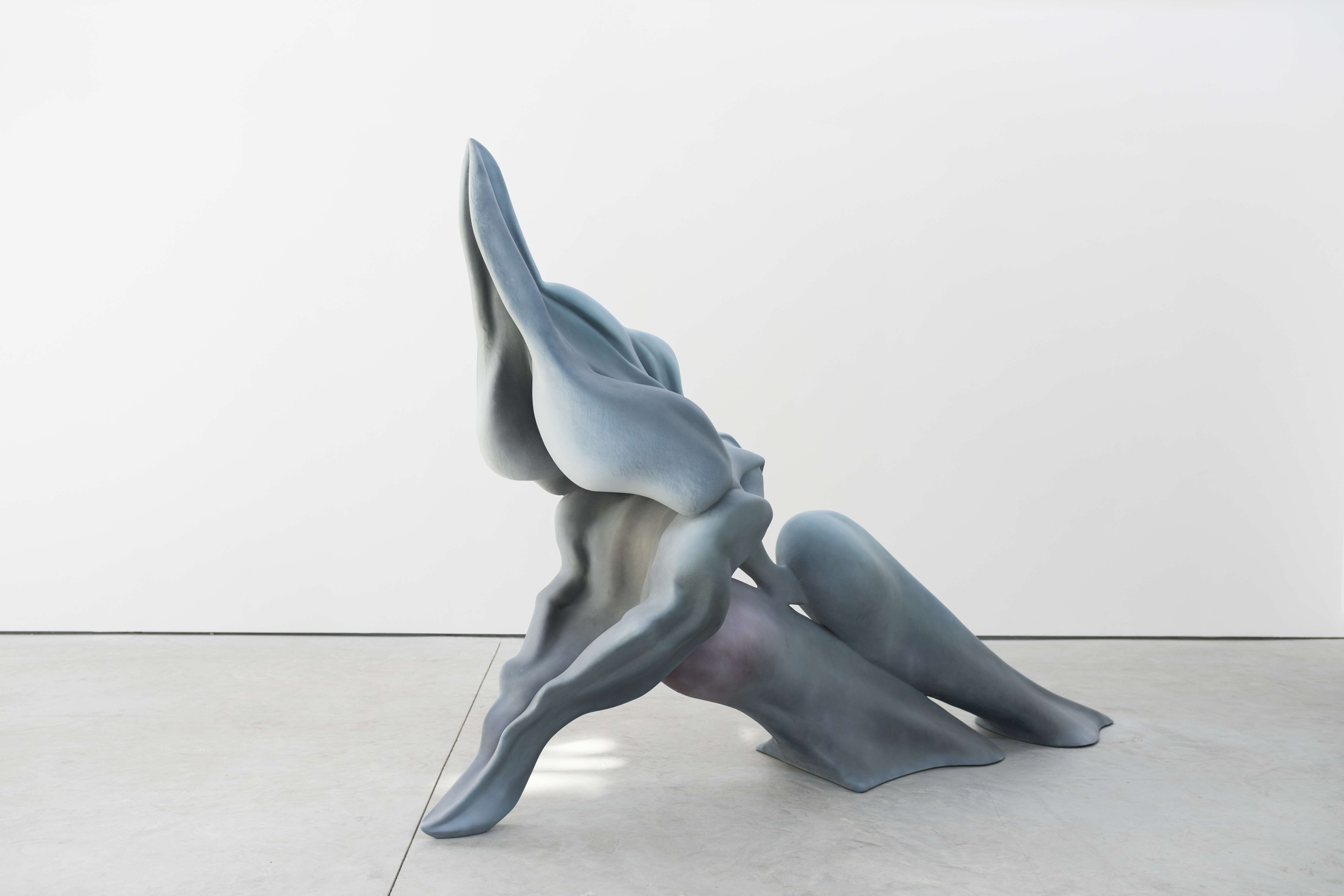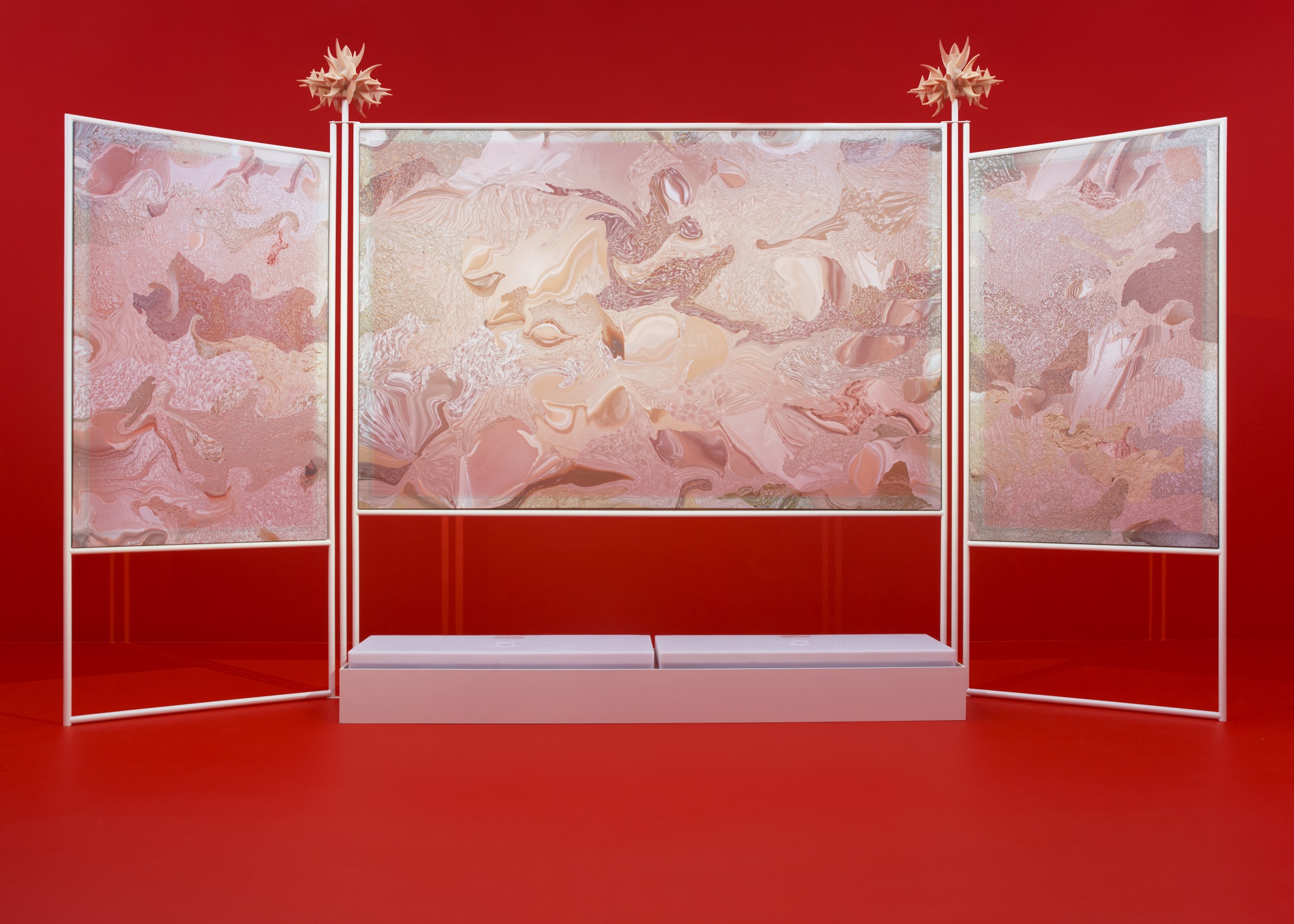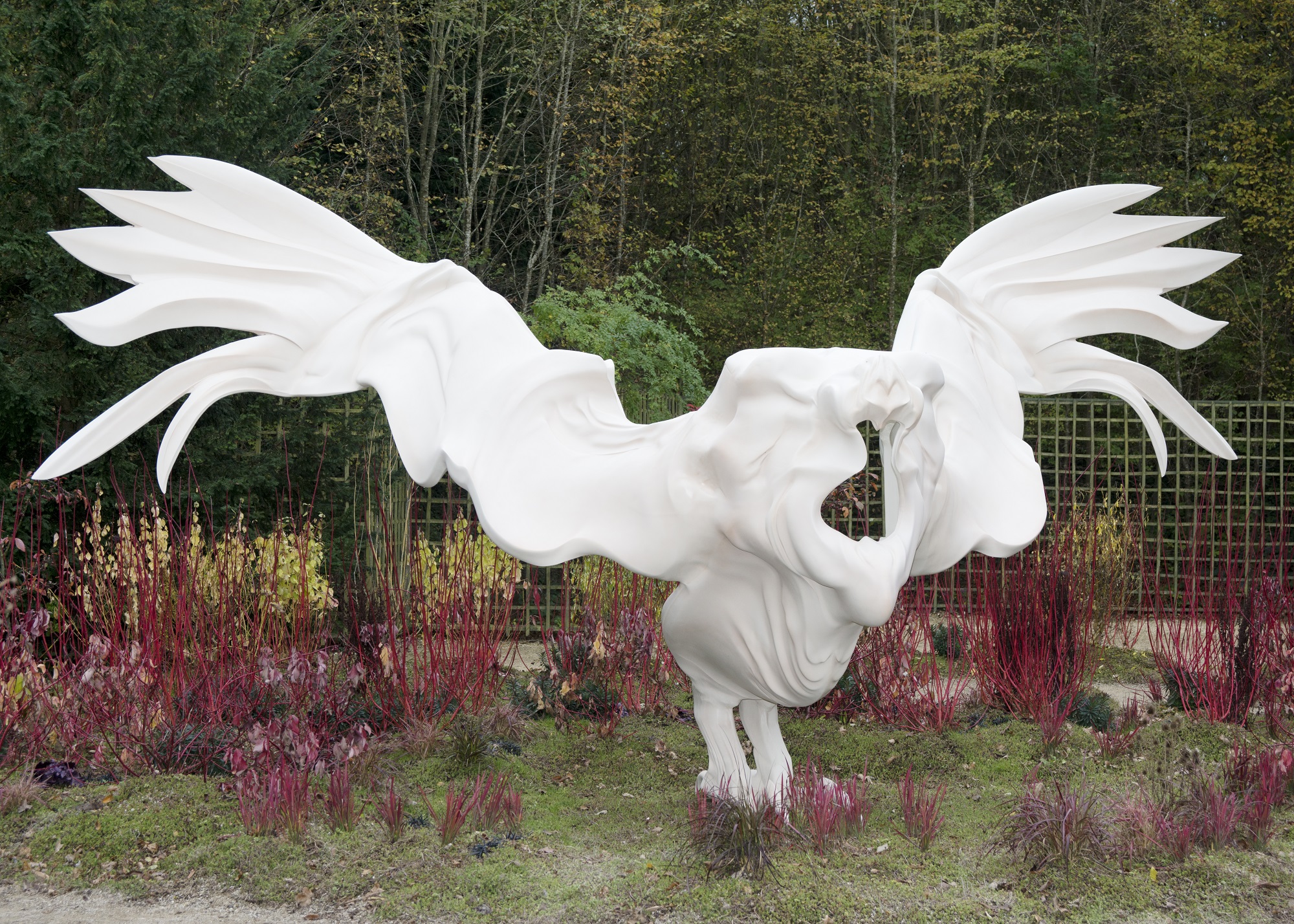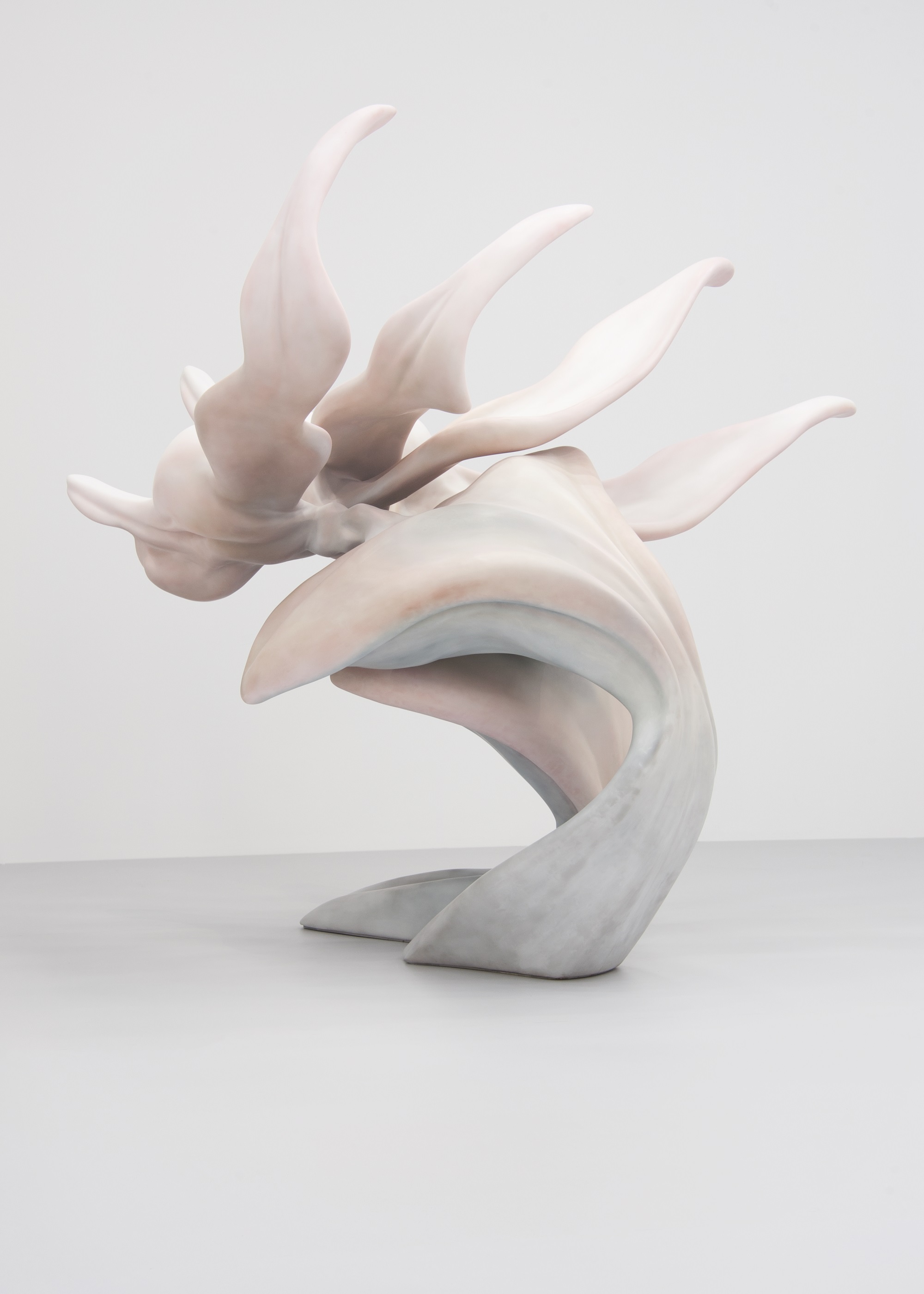
French artist Marguerite Humeau’s practice explores the structures and relationships between living organisms, both human and non-human. Through fantastical sculptures and installations, she asks questions about the formation of our social norms or patterns of behaviour as they relate to biology or evolution. “For centuries we have placed ourselves in the centre of the world,” she explains to me, at her East London studio where she has been based for the past three years. “Research is now showing evidence that many of the features that we humans thought were unique to us are also present in animals.”
Humeau’s work often proposes an alternative way of thinking about our present moment by altering elements of the past. Like much science-fiction, it is grounded in collaborative research with specialists: sociologists, palaeontologists, linguists, psychologists, philosophers and scientists of all kinds, from biologists to behaviourists and cognitive experts. Some of the themes she addresses include: “the consciousness of our death as individuals and as a species, sophisticated language, death rituals, the search for transcendence, the building of temples and organized systems of beliefs”. The sum of these cross-disciplinary connections has the possibility of shifting how we perceive ourselves and our place in the world. “The living kingdom has existed far before we, humans, were born and will probably persist long after we go extinct.”

Humeau’s resulting sculptures sometimes have an otherworldliness to them, combining researched facts with logical speculations to produce computer-rendered creatures with bio-mechanical appendages. Her FOXP2 (2016) project was an example of this strategy, positing “What if the gene responsible for the evolution of language would not have mutated in humans, but in elephants? Would elephants have evolved to become sentient animals, and the most dominant species on Earth?”
“The living kingdom has existed far before we, humans, were born and will probably persist long after we go extinct”
In the FOXP2 exhibition, which takes its name from the gene responsible for speech and language, Humeau asked—and to an extent answered—these questions via a multi-layered installation. Ghostly white mutated pachyderm bodies and heads, including metal armatures, silicone hoses and glass vessels containing reddish fluids, were positioned and dramatically lit on a pinkish stage. The scene encountered by the viewer was of a funerary gathering to mourn the death of the matriarch, a primal moment filled with relatable emotion despite the creatures’ alien form.

Crucially, the material nature of her research also features in Humeau’s work which combines real biological matter alongside synthetic “art” materials. For example, one of the sculptures in FOXP2 contained elephant tears, while other artworks have included snake venom and whale mucus. “This is really important to me,” she emphasizes. “The projects are not fictions, but speculations, and these speculations find their equilibrium in this mix of real facts, science and fictions.”
Humeau’s ability to work between micro- and macro-level research interests, and also across time, is one of the hallmarks of her practice. “All of my projects aim at resuscitating, re-enacting, recreating worlds, ecosystems, voices, beings, creatures, that are prehistoric, extinct, that existed before humans even existed or evolved, or after humans will have disappeared, or that exist or may exist or may have existed in parallel presents.” This unique form of speculative fiction carries through other projects, such as Riddles (2017) which explores real and mythological power structures in the history of humankind, and Ecstasies (2018), which looks at psychoactive parts of animal brains in relation to the history of Venus figurines.

Humeau’s latest project looks to the future in order to investigate the present. She is investigating the possibility that animals are becoming collectively conscious of the detrimental effects that humans are having on the planet. She explains, “It is about how global warming could be triggering the birth of spirituality in animals. With this project, the present time is accelerated to speculate on possible futures that remind us of deep past scenarios such as the Great Flood.”
“My project envisions a world in which mass extinction has accelerated to a point of no return, and therefore in which non-human beings have become spiritual, capable of self-transcendence and mystical experiences. Self-transcendence means for a being to be able to reach beyond and expand the boundaries of the self. This can be expressed in spiritual beliefs; a sense of connection with other living beings, the environment or a higher power.”

The project was inspired by American professor Joseph Campbell’s 1972 book Myths to Live By, in which he discusses human consciousness, mortality and the myth-making process. Campbell’s book sparked a few thoughts in Humeau’s mind: “Is global warming triggering the birth of religion in non-human beings? Global warming and its resulting mass extinctions might be making animals more and more conscious of their own mortality. Could Campbell’s theory apply to the animal kingdom?”
“Global warming and its resulting mass extinctions might be making animals more and more conscious of their own mortality”
Over the course of several months, Humeau looked at evidential cases of intelligent behaviour and ritual in animals. “Chimpanzees have been recently observed piling rocks in what may be an initial attempt to build some form of temple. Self-destructive, suicidal behaviours have been witnessed in many non-human animals such as dolphins, whales, elephants or giraffes. Similarly, research has shown that some animals bury their dead, and have developed death rituals that might suggest that they believe in some kind of afterlife.”

To date, Humeau’s research has manifested itself in two recent exhibitions, High Tide (2019) at Centre Pompidou, Paris, and Mist (2019) at Clearing, Brussels. Both contain new groups of exotic aquatic creatures that seem to perform collective rituals as their biomorphic design allows—through breathing or singing. “The recognition of mortality and the requirement to transcend it is the first great impulse to the birth of myths and religion. These observed behaviours might be the first hint of an initial feeling or hope that there could be a certain form of existence even after death.” Though directed at each other, the exchanges between creatures are witnessed by us, and although their communication seems unintelligible, it has the tone of a lament. If these animals have travelled from the future to warn of extinction, they are making an emotional appeal to our beliefs and convictions in the present.





